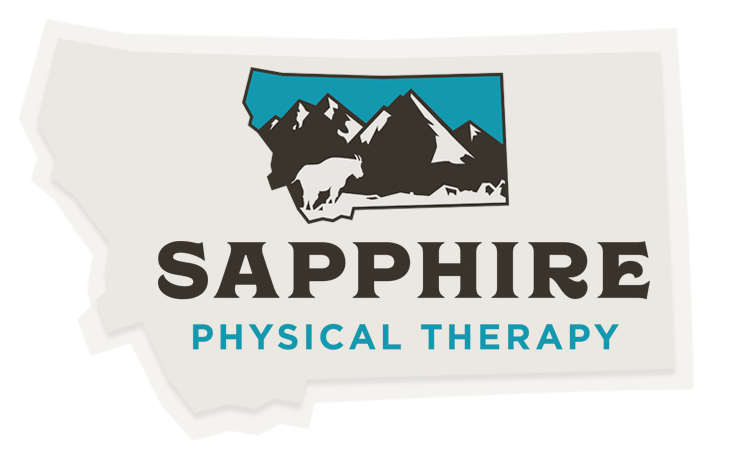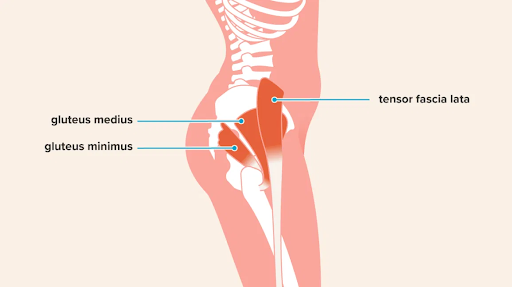Addressing lateral hip pain in runners
Lateral hip pain (hip pain located on the outside of your hip) is common in runners. The hip abductor muscles are located on the outside of the hip. These muscles include the gluteus medius and minimus muscles and tensor fascia lata. These muscles control the alignment of the hip and pelvis when we run.
Contralateral pelvic drop and hip adduction occurs during the loading phase of the gait cycle. As one weightbears on the left side, the pelvis will drop on the right side and the left hip/femur will fall inward towards midline. As this occurs, the hip abductor muscles are contracting eccentrically to control the movement.
Training errors along with certain running biomechanics place us at risk for developing a running related injury. Excessive pelvic drop and hip adduction can contribute to an increased risk of developing gluteal tendinopathy or a gluteus medius/minimus muscle strain, especially when we also have exceeded our tissue’s load capacity through an abrupt increase in running mileage or intensity.1,2
Excessive pelvic drop and/or hip adduction increase compressive loads at the distal insertion of our gluteal tendons at the greater trochanter. This can eventually lead to tendinopathy and lateral hip pain also known as Greater Trochanter Pain Syndrome. Pain is often felt when lying on the affected side, climbing stairs, with single leg activities, and with running especially uphill. The excessive eccentric loads placed on the muscle tissue with this type of mechanic also increase the risk of developing a gluteal muscle strain as well.1
Injury risk reduction and treatment for this type of condition includes gait retraining and hip abductor strengthening. The easiest way to reduce pelvic drop and/or hip adduction during running is to reduce time spent on the ground by increasing step rate/cadence. Increasing preferred running cadence by 5-10% has been shown to reduce contralateral pelvic drop and hip adduction during stance phase. The easiest way to increase cadence is to practice on a treadmill where speed can be kept constant. Determine preferred cadence by using a watch that is able to track step rate or by using a metronome app on the phone. Then increase by 5-10% and set that cadence on the metronome app and try to match this rate when running.3
Another way to improve load tolerance or gluteal tissue capacity is to work on hip abductor strengthening to miminick the eccentric loads/demands of running. The exercises of choice may depend on whether the individual is currently in pain or using them for injury risk reduction. If pain is present it is important to stick with isometrics and strengthen through a smaller range of motion to avoid increased compressive type loads to the tendons and eccentric loads on the muscle. Some ideas for isometric exercises for the hip abductors include side plank holds on the knee progressing to a full side plank when able and resisted hip abduction isometric holds with band resistance.
When progressing it is important to also add increased resistance or weight to some of the exercises to simulate the demands of running. Here are some of my favorite exercises. *Keep in mind it is important to limit range of motion through the exercises early on to avoid excessive compressive and eccentric loads.
Side plank with leg raise
Single leg deadlift (weight in contralateral side)
Side plank with hip dip
Step up with weight in contralateral hand
Weighted split squat/lunge
Standing hip abduction with band resistance
Weighted marching
At Sapphire Physical Therapy we use a 2D video running gait analysis system to capture mechanics that may increase the risk of developing certain types of running related injuries. Don’t let nagging pains or injuries get the best of your spring running goals. Call to schedule today, 406-549-5283.
Written by Holly Warner, PT, DPT
References:
Grimaldi A, Fearon A. Gluteal Tendinopathy: Integrating Pathomechanics and Clinical Features in Its Management. Journal of Orthopaedic & Sports Physical Therapy. 2015;45(11):910-922. doi:10.2519/jospt.2015.5829
Heiderscheit B, McClinton S. Evaluation and Management of Hip and Pelvis Injuries. Physical Medicine and Rehabilitation Clinics of North America. 2016;27(1):1-29. doi:10.1016/j.pmr.2015.08.003
Wille CM, Stiffler-Joachim MR, Heiderscheit BC. Influence of Step Rate on Running Mechanics. Clinical Care of the Runner. 2020:75-85. doi:10.1016/b978-0-323-67949-7.00008-2





















